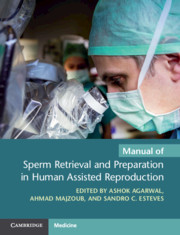Book contents
- Manual of Sperm Retrieval and Preparation in Human Assisted Reproduction
- Cambridge Laboratory Manuals in Assisted Reproductive Technology
- Manual of Sperm Retrieval and Preparation in Human Assisted Reproduction
- Copyright page
- Dedication
- Contents
- Contributors
- Editor Biographies
- Preface
- Part I Introduction
- Part II Sperm Retrieval
- Chapter 4 History of Surgical Sperm Retrieval Techniques
- Chapter 5 Epididymal Sperm Retrieval
- Chapter 6 Testicular Sperm Retrieval
- Chapter 7 Surgical and Nonsurgical Sperm Retrieval Techniques in Patients with Ejaculatory Dysfunctions
- Chapter 8 Sperm Retrieval in Non-azoospermic Men
- Chapter 9 Predictors of Positive Surgical Sperm Retrieval in Azoospermic Males
- Chapter 10 Methods for Enhancing Surgical Sperm Retrieval Success
- Part III Laboratory Handling of Retrieved Sperm
- Index
- References
Chapter 10 - Methods for Enhancing Surgical Sperm Retrieval Success
from Part II - Sperm Retrieval
Published online by Cambridge University Press: 09 April 2021
- Manual of Sperm Retrieval and Preparation in Human Assisted Reproduction
- Cambridge Laboratory Manuals in Assisted Reproductive Technology
- Manual of Sperm Retrieval and Preparation in Human Assisted Reproduction
- Copyright page
- Dedication
- Contents
- Contributors
- Editor Biographies
- Preface
- Part I Introduction
- Part II Sperm Retrieval
- Chapter 4 History of Surgical Sperm Retrieval Techniques
- Chapter 5 Epididymal Sperm Retrieval
- Chapter 6 Testicular Sperm Retrieval
- Chapter 7 Surgical and Nonsurgical Sperm Retrieval Techniques in Patients with Ejaculatory Dysfunctions
- Chapter 8 Sperm Retrieval in Non-azoospermic Men
- Chapter 9 Predictors of Positive Surgical Sperm Retrieval in Azoospermic Males
- Chapter 10 Methods for Enhancing Surgical Sperm Retrieval Success
- Part III Laboratory Handling of Retrieved Sperm
- Index
- References
Summary
Patients with azoospermia were once considered to be infertile, with few treatment options. A number of sperm retrieval methods have been developed to obtain spermatozoa from the epididymis and testicles of azoospermic men. This chapter addresses methods for enhancing surgical sperm retrieval and highlights the techniques, imaging modalities, medical therapies, and additional procedures that have led to this increased success.
- Type
- Chapter
- Information
- Publisher: Cambridge University PressPrint publication year: 2021

